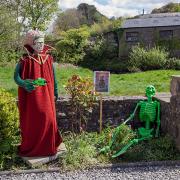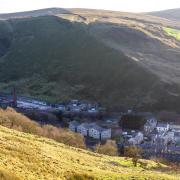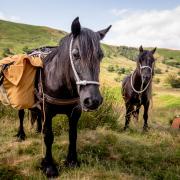Not far from the world famous Oswaldtwistle Mills, Foxhill Bank is a popular nature reserve for wildlife and humans.
My favourite moment at Foxhill came while I was being interviewed live on BBC Radio Lancashire, and I spotted a kingfisher. I was cool and descriptive of his beautiful bird while the reporter was hopping with excitement. My cool was all exterior, inside my heart was beating like a drum.
I have seen kingfishers a couple of times on the cutely named Tinker Brook, which runs through the length of this nature reserve and on the Heart Lodge, which is shaped like a heart.

At the north-eastern end of the reserve, Tinker Brook gets a bit more lively and I spent a good half hour watching dippers fishing for food. Dippers tend to hunt in clean streams so that’s a good example of how well the site is maintained by reserve officer Kim Coverdale and her team of officers and volunteers.
Recently the team has been carefully cutting and raking meadows making room for next year’s spring flowers.
Foxhill Bank is nestled in a shallow valley with the lodges and brook running along one side and woodland and paths on the other.

The lodges were constructed for storing water for the dyeing and printing of fabrics, at mills owned by the Brewer family. Like many mills, they fell into disuse and became shopping outlets or completely collapsed and were taken back by nature.
Other Wildlife Trust reserves in the North West are similar, nature is now covering signs of mills, pits and steelworks at Longworth Clough in Bolton, and Kirkless in Wigan. Nature is back, with some help from your local Wildlife Trust officers and volunteers.
At Foxhill Bank there is now a mosaic of open water, reedmace, soft, hard and jointed rush and newly planted common reed.
In the woodland there is an avenue of lime trees that would have led up to the former mill owner’s house. The buildings and stonework have been completely removed, but a section of the avenue and some specimen trees from the garden still remain.

Foxhill is popular with birds like great spotted woodpecker, siskin, reed bunting and blackcap, enjoying the variety of habitats. Mallards, coots and moorhens seem to rule the lodges but, in the coming months, look out for frogs, toads and newts returning to breed. There is plenty food to attract herons, which are regularly spotted around the waters.
Kim has a nice tale from a recent encounter. She said: ‘We had a problem after someone lifted a heavy drain cover on the main lodge overflow and dropped it down the chamber.
‘I called out a local company to retrieve the drain cover. It turned out the engineer grew up in a house overlooking Foxhill Bank. He told me he used to visit the site with his dad and described the reserve from his childhood. He also knows the culverts and has walked through and worked on them.’
This is a nature reserve loved and respected by the community because it has been allowed to rewild itself and is creating a new chapter in its history.




























